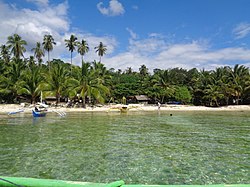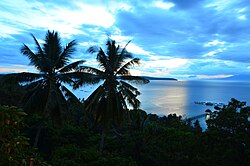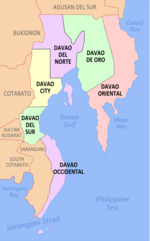Davao del Norte
Davao del Norte | |
|---|---|
(from top: left to right) Kaputian Island, Tagum City, Bigiw boats in Samal, Davao Gulf, Panabo City and Samal Island. | |
| Etymology: Davao del Norte (i.e., "Northern Davao") | |
| Nickname: "Banana Capital of the Philippines" | |
 Location in the Philippines | |
| Coordinates: 7°21′N 125°42′E / 7.35°N 125.7°E | |
| Country | Philippines |
| Region | Davao Region |
| Founded | May 8, 1967 |
| Capital and largest city | Tagum |
| Government | |
| • Governor | Edwin I. Jubahib (PFP) |
| • Vice Governor | De Carlo L. Uy[a] (Independent) |
| • Legislature | Davao del Norte Provincial Board |
| Area | |
| • Total | 3,422.61 km2 (1,321.48 sq mi) |
| • Rank | 39th out of 81 |
| Highest elevation | 1,115 m (3,658 ft) |
| Population (2020 census)[3] | |
| • Total | 1,125,057 |
| • Rank | 25th out of 81 |
| • Density | 330/km2 (850/sq mi) |
| • Rank | 24th out of 81 |
| Demonym | Northern Davaoeño |
| Divisions | |
| • Independent cities | 0 |
| • Component cities | |
| • Municipalities | |
| • Barangays | 223 |
| • Districts | Legislative districts of Davao del Norte |
| Time zone | UTC+8 (PHT) |
| ZIP code | 8100–8178 |
| IDD : area code | +63 (0)84 |
| ISO 3166 code | PH-DAV |
| Spoken languages | |
| Income classification | 1st class |
| Website | www |
Davao del Norte (Cebuano: Amihanang Dabaw; Filipino: Hilagang Davao), officially the Province of Davao del Norte (Cebuano: Lalawigan sa Amihanang Dabaw, Lalawigan sa Davao del Norte; Filipino: Lalawigan ng Hilagang Davao, Lalawigan ng Davao del Norte), is a province in the Philippines located in the Davao Region in Mindanao. Its capital and largest city is Tagum. The province also includes Samal Island to the south in Davao Gulf.
Before 1967, the five provinces—Davao de Oro, Davao del Norte, Davao del Sur, Davao Occidental, Davao Oriental—and Guipuzcoa were administered as a single province named Davao, a provincial district of the Department of Mindanao and Sulu. The present-day Davao Region is coterminous with this former province.
Davao del Norte is also known as "The Banana Capital of the Philippines."
History
[edit]Davao del Norte and Davao de Oro (Compostela Valley) by R.A. 8470, January 30, 1998, together with Davao Oriental, and Davao Occidental from Davao del Sur by R.A. 10360, January 14, 2013, used to be a whole province simply known as Davao Region. This original province was split into three: Davao del Norte, Davao Oriental, and Davao del Sur when Republic Act No. 4867 (authored by Representative Lorenzo S. Sarmiento, Sr.) was signed into law on May 8, 1967, by President Ferdinand Marcos.[4]
Davao del Norte originally comprised thirteen municipalities: Asuncion, Babak (now in Samal), Compostela, Kapalong, Mabini, Mawab, Monkayo, Nabunturan, Panabo, Pantukan, Samal, Santo Tomas and Tagum. On May 6, 1970, six more municipalities were created: Carmen, Kaputian (now in Samal), Maco, Montevista, New Bataan, and New Corella.
The passage of Republic Act No. 6430 on June 17, 1972, changed the name of the province from Davao del Norte to Davao.[5]
By 1996, Davao had a total of twenty-two municipalities with the creation of San Vicente (now Laak) in 1979,[6] Maragusan in 1988,[7][8] and Talaingod in 1991.[9]
On January 31, 1998, President Fidel V. Ramos signed Republic Act No. 8470, which split the province into two, creating the province of Davao de Oro (Compostela Valley).[10] In the meantime, Davao was renamed back to Davao del Norte. Together with the creation of the new province, two cities and one municipality were created: the municipality of Tagum, capital of Davao del Norte, was converted into a city (R.A. 8472);[11] Samal, Babak, and Kaputian were joined into the city of Samal (R.A. 8471);[12] and the municipality of Braulio E. Dujali was created out of several barangays in Panabo and Carmen (R.A. 8473).[13] The province then had 8 municipalities and 2 cities.
Republic Act No. 9015, signed into law on March 5, 2001, by President Gloria Macapagal Arroyo, converted the municipality of Panabo into a city.[14] Republic Act No. 9265, approved on March 15, 2004, created the municipality of San Isidro from Asuncion and Kapalong.[15]
Geography
[edit]Davao del Norte covers a total area of 3,426.97 square kilometres (1,323.16 sq mi)[16] occupying the north-central section of the Davao Region. The province borders Agusan del Sur to the north, Bukidnon to the west, Davao de Oro to the east, and Davao City to the south.
Samal is the only municipality or city in the province not situated on Mindanao island. The city covers the entire Samal and Talikud Islands within Davao Gulf.
Administrative divisions
[edit]Davao del Norte comprises eight municipalities and three cities.

| ||||||||||||||||||||||||||||||||||||||||||||||||||||||||||||||||||||||||||||||||||||||||||||||||||||||||||||||||||||||||||||||||||||||||||||||||||||||||||||||||||||||||||||||||||||||||||||
Demographics
[edit]| Year | Pop. | ±% p.a. |
|---|---|---|
| 1903 | 9,554 | — |
| 1918 | 23,701 | +6.24% |
| 1939 | 60,349 | +4.55% |
| 1948 | 91,367 | +4.72% |
| 1960 | 262,889 | +9.21% |
| 1970 | 442,543 | +5.34% |
| 1975 | 589,697 | +5.93% |
| 1980 | 725,153 | +4.22% |
| 1990 | 1,056,301 | +3.83% |
| 1995 | 1,191,443 | +2.28% |
| 2000 | 743,811 | −9.61% |
| 2007 | 847,440 | +1.82% |
| 2010 | 945,764 | +4.08% |
| 2015 | 1,016,332 | +1.38% |
| 2020 | 1,125,057 | +2.02% |
| data prior to 2000 excludes municipalities under Davao de Oro that were part of the province until 1998 Source: Philippine Statistics Authority[17][18][18][19] | ||
Davao del Norte had a population of 1,125,057 in the 2020 census.[3] The population density was 297/km2 (768/sq mi). The main languages spoken are Cebuano and Davawenyo while English and Filipino are also widely spoken.
Indigenous groups
[edit]Talaingod is the home of many Indigenous groups in Davao del Norte, with most of them Lumads and Aetas.
Economy
[edit]Davao del Norte is a primarily agricultural, but also engages in mining, forestry, and commercial fishing.
The principal crops of the province include rice, maize, banana, coconut, abacá, ramie, coffee, and a variety of fruit and root crops. Davao del Norte is the country's leading producer of bananas, with many plantations run by multinationals Dole and Del Monte, and local producers such as Lapanday, TADECO, and Marsman. Davao del Norte is also one of Mindanao's leading producer of rice.
Davao Gulf, to the south of the province, provides a living for many fisherfolk. Some of the fish products include brackish water milkfish, tilapia, shrimp, and crab; and freshwater catfish and tilapia.
Davao del Norte is a major producer of gold, and its mining resources include silica, silver, copper, and elemental sulfur. Small-scale gold mining activities thrive in several areas. There are also numerous active quarries of commercial quantities of gravel, sand, and pebbles for construction.
Tourism is also a major part of the economy of Davao del Norte. There are a lot of beaches on Samal Island, the most famous of which is Pearl Farm Beach Resort. Banana Beach Resort is the most famous beach outside of Samal Island.
Commerce is also a major part of the economy of Davao del Norte. There are lot of shopping malls in Tagum.
Notable people
[edit]- Jerwin Ancajas - boxer
- Dennis Denora - journalist and publisher
- Thor Dulay - The Voice Ph semifinalist
- Jasmine Bacurnay Lee - Korean actress and politician
- Arrel Olaño - politician
- Jay Durias - singer
- Maris Racal - actress and runner-up of Pinoy Big Brother: All In
- Iwa Moto - actress, model and runner up of StarStruck (season 3)
- Edralyn P. Sonit - leaf musician, businessgirl
- Rey T. Uy, businessman, politician - then Mayor of Tagum 1998 -2001, 2004-2013 2022-present
- Allan L. Rellon - politician former mayor of Tagum 2013–2022
- Pantaleon Alvarez - politician, the current Speaker of the House of Representatives of the Philippines and a Congressman from the First District of Davao del Norte
- Yesha Camile - child actress in ABS-CBN and host for Team Yey!
- Lie Reposposa - former housemate of Pinoy Big Brother: Otso
Notes
[edit]References
[edit]- ^ Patumbon, Rojean Grace (April 11, 2024). "Vice Gov. Uy to temporarily replace Jubahib as DavNor guv". SunStar. SunStar Publishing. Retrieved April 13, 2024.
- ^ "List of Provinces". PSGC Interactive. Makati, Philippines: National Statistical Coordination Board. Archived from the original on January 17, 2013. Retrieved April 24, 2014.
- ^ a b c Census of Population (2020). "Region XI (Davao Region)". Total Population by Province, City, Municipality and Barangay. Philippine Statistics Authority. Retrieved July 8, 2021.
- ^ "Republic Act No. 4867 - An Act Creating the Provinces of Davao del Norte, Davao del Sur and Davao Oriental". Republic Acts. Chan Robles Virtual Law Library. Retrieved April 25, 2014.
- ^ "Republic Act No. 6430 - An Act Changing the Name of the Province of Davao del Norte to Province of Davao". Republic Acts. Chan Robles Virtual Law Library. Retrieved April 25, 2014.
- ^ "Batas Pambansa Blg. 23; An Act Creating the Municipality of San Vicente in the Province of Davao del Norte". The Corpus Juris. April 4, 1979. Retrieved March 19, 2016.
- ^ "Presidential Decree No. 1247; Creating the Municipality of San Mariano in the Province of Davao". Chan Robles Virtual Law Library. Malacañang, Manila, Philippines. November 25, 1977. Retrieved March 19, 2016.
- ^ "Republic Act No. 6678; An Act Changing the Name of the Municipality of San Mariano in the First District of the Province of Davao del Norte to Municipality of Maragusan". Official Gazette of the Republic of the Philippines. Congress of the Philippines. October 12, 1988. Retrieved March 19, 2016.
- ^ "Republic Act No. 7081; An Act Creating the Municipality of Talaingod in the Province of Davao". Chan Robles Virtual Law Library. July 29, 1991. Retrieved January 28, 2016.
- ^ "Republic Act No. 8470 - An Act Creating the Province of Compostela Valley from the Province of Davao del Norte, and for Other Purposes". Republic Acts. Chan Robles Virtual Law Library. Retrieved April 25, 2014.
- ^ "Republic Act No. 8472 - An Act Converting the Municipality of Tagum, Davao Province, Into a Component City to be Known as the City of Tagum". Chan Robles Virtual Law Library. Retrieved December 16, 2015.
- ^ "Republic Act No. 8471 - An Act Constituting the Three Municipalities of Babak, Samal and Kaputian of Samal Island, Province of Davao, Into a Component City to be Known as the Island Garden City of Samal". Chan Robles Virtual Law Library. Retrieved December 16, 2015.
- ^ "Republic Act No. 8473 - An Act Creating the Municipality of Braulio E. Dujali in the Province of Davao, and for Other Purposes". Chan Robles Virtual Law Library. Retrieved December 16, 2015.
- ^ "Republic Act No. 9015; An Act Converting the Municipality of Panabo, Province of Davao del Norte Into a Component City to be Known as the City of Panabo". Chan Robles Virtual Law Library. Retrieved December 16, 2015.
- ^ "Republic Act No. 9265; An Act Creating the Municipality of San Isidro in the Province of Davao del Norte". The LawPhil Project. Retrieved December 16, 2015.
- ^ a b c "Province: Davao del Norte". PSGC Interactive. Quezon City, Philippines: Philippine Statistics Authority. Retrieved January 8, 2016.
- ^ a b Census of Population (2015). "Region XI (Davao Region)". Total Population by Province, City, Municipality and Barangay. Philippine Statistics Authority. Retrieved June 20, 2016.
- ^ a b Census of Population and Housing (2010). "Region XI (Davao Region)" (PDF). Total Population by Province, City, Municipality and Barangay. National Statistics Office. Retrieved June 29, 2016.
- ^ "Philippines Census Of Population of all LGUs 1903-2007". archive.org. Philippine Statistics Authority. Retrieved March 11, 2017.
- ^ "Poverty incidence (PI):". Philippine Statistics Authority. Retrieved December 28, 2020.
- ^ "Estimation of Local Poverty in the Philippines" (PDF). Philippine Statistics Authority. November 29, 2005.
- ^ "2009 Official Poverty Statistics of the Philippines" (PDF). Philippine Statistics Authority. February 8, 2011.
- ^ "Annual Per Capita Poverty Threshold, Poverty Incidence and Magnitude of Poor Population, by Region and Province: 1991, 2006, 2009, 2012 and 2015". Philippine Statistics Authority. August 27, 2016.
- ^ "Annual Per Capita Poverty Threshold, Poverty Incidence and Magnitude of Poor Population, by Region and Province: 1991, 2006, 2009, 2012 and 2015". Philippine Statistics Authority. August 27, 2016.
- ^ "Annual Per Capita Poverty Threshold, Poverty Incidence and Magnitude of Poor Population, by Region and Province: 1991, 2006, 2009, 2012 and 2015". Philippine Statistics Authority. August 27, 2016.
- ^ "Updated Annual Per Capita Poverty Threshold, Poverty Incidence and Magnitude of Poor Population with Measures of Precision, by Region and Province: 2015 and 2018". Philippine Statistics Authority. June 4, 2020.
- ^ "2021 Full Year Official Poverty Statistics of the Philippines" (PDF). Philippine Statistics Authority. August 15, 2022. Retrieved April 28, 2024.
External links
[edit] Media related to Davao del Norte at Wikimedia Commons
Media related to Davao del Norte at Wikimedia Commons Geographic data related to Davao del Norte at OpenStreetMap
Geographic data related to Davao del Norte at OpenStreetMap










